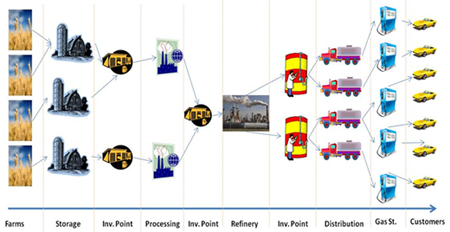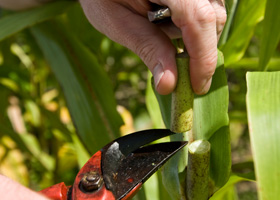Sustainability, Marketing and Policy
The US-India Consortium for Development of Sustainable Advanced Lignocellulosic Biofuel Systems is committed to researching and developing advanced clean energy technologies including biomass-based advanced biofuel systems and bio-based products. Within this overarching agenda, the Work Package 3 research group deals with the sustainability, marketing and policy of advanced biofuels produced from switch grass in United States and from sorghum, bamboo and pearl millet biomass in India.
Sustainability: Goals
- Analyze and develop certification protocols and sustainability standards for advanced biofuels
- Conduct energy, emissions, and economic analysis to assess viability of advanced biofuels and associated tradeoffs
- Perform supply chain management analysis of the production, distribution, marketability, and sustainable attributes of food based and non-food biomass based biofuels.
Sustainability: Project Documents and Details
WP3 Project Update – August, 2014
-
Standards and certification protocols
-
The group will develop a set of sustainability indicators for the advanced biofuels. Standards similar to those developed for sustainable feedstock management, energy balances, greenhouse gas emission reductions, and existing codes and guidelines for biomass harvesting/collection, transport and conversion will be used to create some of these indicators. The learning from feedstock production and conversion conducted by project members will be used to develop standards and protocols. Comparative analyses of standards and protocols prepared for both countries are proposed so that stakeholders can adapt these standards and protocols according to feedstock, technology and country-specific socioeconomic milieu.
-
-
Energy, emissions, and economic analyses
-
Energy and greenhouse of switchgrass based butanol in United States and advanced biofuels in India will be ascertained through life cycle analysis. The carbon balance of advanced biofuel systems and total emissions of greenhouse gas from different feedstock based biofuel regimes will be evaluated. The micro-level feedstock-based analyses, along with cost-benefit information, will be used to assess economic viability of clean energy technologies for the production of advanced biofuels. Environmental consequences, such as carbon offsets and impacts on long-term land productivity, will be accounted for and examined via tradeoff analysis. The income and employment impacts (including total and distributional impacts) of advanced biofuels will also be analyzed. The expansion of advanced biofuels production represents a tremendous opportunity to enhance economic vitality of the rural economy for both countries.
-
-
Supply chain management analyses
-
The group will analyze supply chain aspects affecting the production and sustainability of biofuels, and identify drivers and barriers impacting the marketability and distribution of non-food biomass based biofuels. Supply chain management addresses all the activities related to the procurement, production, and delivery of the final good or services to the end user (Figure-1). The group will identify barriers and drivers affecting the marketability and distribution of biofuels, and evaluate markets for production facilities including distribution intermediaries on the demand side.
 Figure 1.Supply chain of a biofuels
Figure 1.Supply chain of a biofuelsSuccessful completion of the center’s work will benefit both the U.S. and India by delivering a working model for feedstock production and supply, biochemical conversion approaches and technologies that have been validated on pre-commercial scale systems, and overall economics and sustainability of biofuel production and supply systems. It is envisaged that the activities will develop a multi-institutional biofuels’ network using a public-private partnership model.
-
Sustainability: Project Research Publications
-
2018
- van Rijn, R., I.U. Nieves, K.T. Shanmugam, L.O. Ingram, and W. Vermerris. (2018). Techno-Economic Evaluation of Cellulosic Ethanol Production Based on Pilot Biorefinery Data: a Case Study of Sweet Sorghum Bagasse Processed via L+SScF. BioEnergy Research 11(2):414-425. DOI: 10.1007/s12155-018-9906-3.
-
2017
- Burli, P. (2017). Economic and Environmental Assessment of Advanced Biofuels: Adoption Under Uncertainty, Farmer Willingness, and Land Use Implications. (Doctoral dissertation). Retrieved from ProQuest Dissertations and Theses database. (UMI No.10742840). https://search.proquest.com/docview/1993479598
- Burli, P., Forgoston, E., Lal, P., Billings, L. and Wolde, B. (2017). Adoption of switchgrass cultivation for biofuel under uncertainty: A discrete-time modeling approach. Biomass and Bioenergy 105:107-115. DOI: 10.1016/j.biombioe.2017.06.012
- Wolde, B., Lal, P. and Burli, P. (2017). Forestland owners’ willingness to consider multiple ways of supplying biomass simultaneously: Implications for biofuel incentive policies. Energy Policy 105:183-190. DOI: 10.1016/j.enpol.2017.02.040
-
2016
- Burli, P., Lal, P., Wolde, B. and Alavalapati, J. (2016). Sustainability protocols and certification criteria for switchgrass-based bioenergy. BioResources 11(3):7102-7123.
DOI: 10.15376/biores.11.3.7102-7123 - Golecha, R. and Gan, J. (2016). Biomass transport cost from field to conversion facility when biomass yield density and road network vary with transport radius. Applied Energy 164:321-331. DOI: 10.1016/j.apenergy.2015.11.070
- Golecha, R., and Gan, J. (2016). Cellulosic biorefinery portfolio and diversification: Strategies to mitigate cellulosic biorefinery risks in US Corn Belt. Energy Strategy Reviews 13/14:147-153. DOI: 10.1016/j.esr.2016.09.003
- Golecha, R. and Gan, J. (2016). Effects of corn stover year-to-year supply variability and market structure on biomass utilization and cost. Renewable and Sustainable Energy Reviews 57:34-44. DOI: 10.1016/j.rser.2015.12.075
- Lal, P., Wolde, B., Alavalapati, J., Burli, P. and Munsell, J. (2016). Forestland owners' willingness to plant pine on non-forested land for woody bioenergy in Virginia. Forest Policy and Economics 73:52-57. DOI: 10.1016/j.forpol.2016.09.003n
- Wolde, B., Lal, P., Alavalapati, J., Burli P. and Iranah. P. (2016). Soil and water conservation using the socioeconomics, sustainability concerns, and policy preference for residual biomass harvest. Journal of Soil and Water Conservation 71(6):476-483.
DOI: 10.2489/jswc.71.6.476 - Wolde, B., Lal, P., Alavalapati, J., Burli, P. and Munsell, J. (2016). Factors affecting forestland owners' allocation of non-forested land to pine plantation for bioenergy in Virginia. Biomass and Bioenergy 85:69-75.
DOI: 10.1016/j.biombioe.2015.12.007 - Wolde, B., Lal, P., Gan, J., Alavalapati, J., Taylor, E. and Burli, P. (2016). Determinants of enrollment in public incentive programs for forest management and their effect on future programs for woody bioenergy: evidence from Virginia and Texas. Canadian Journal of Forest Research 46(6):775-782. DOI: 10.1139/cjfr-2015-0335
- Burli, P., Lal, P., Wolde, B. and Alavalapati, J. (2016). Sustainability protocols and certification criteria for switchgrass-based bioenergy. BioResources 11(3):7102-7123.
-
2015
- Lal, P., Burli, P. and Alavalapati, J. (2015). Policy Mechanisms to Implement and Support Biomass and Biofuel Projects in United States. In: Jose, S. and Bhaskar, T. (eds.), Biomass and Biofuels: Advanced Biorefineries for Sustainable Production and Distribution. CRC Press, Boca Raton, FL. pp. 279-301.
- Lal, P., Kebede, E., Wolde, B., Burli, P., Alavalapati, J., Gan, J. and Taylor, E. (2015). Assessing Socioeconomic Impacts of Forest Biomass Based Biofuel Development on Rural Communities in the Southern United States. In: J. Janick, A. Whipkey and V.M. Cruz (eds.), New Crops: Bioenergy, Biomaterials, and Sustainability, Proceedings of the Joint Annual Meeting of the Association for the Advancement of Industrial Crops and the USDA National Institute of Food and Agriculture, Washington, DC, October 12-16, 2013. pp. 382-398. https://hort.purdue.edu/newcrop/proceedings2015/382-lal.pdf
- Withers, J., Quesada-Pineda, H.J. and Smith, R. (2015). Internal and external barriers impacting non-food cellulosic biofuel projects in the United States. BioResources 10(3):3874-3889. DOI: 10.15376/biores.10.3.3874-3889
-
2014
- Gan, J., J.W.A. Langeveld and C.T. Smith (2014). An agent-based modeling approach for determining corn stover removal rate and transboundary effects. Environmental Management 53(2):333-342. DOI: 10.1007/s00267-013-0208-4
Biofuel Information

Cutting a sample of sorghum for test purposes. Sorghum crops, biofuel production.